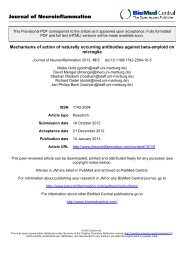View PDF - Journal of Neuroinflammation
View PDF - Journal of Neuroinflammation
View PDF - Journal of Neuroinflammation
You also want an ePaper? Increase the reach of your titles
YUMPU automatically turns print PDFs into web optimized ePapers that Google loves.
Krstic et al. <strong>Journal</strong> <strong>of</strong> <strong>Neuroinflammation</strong> 2012, 9:151 Page 20 <strong>of</strong> 23<br />
http://www.jneuroinflammation.com/content/9/1/151<br />
Conclusion<br />
We provide experimental evidence for a causative and<br />
exacerbating role <strong>of</strong> systemic immune challenges on the<br />
development <strong>of</strong> AD-like neuropathology in vivo, thereby<br />
supporting recent genome-wide association studies [4],<br />
retrospective epidemiological human studies [5,6,12], and<br />
the long-standing infection/neuroinflammation-based AD<br />
hypotheses [11,22,33,61]. Furthermore, our data support<br />
the use <strong>of</strong> anti-inflammatory drugs [12] in the treatment<br />
<strong>of</strong> patients during the initial asymptomatic stages <strong>of</strong> AD<br />
[16], and confirm the importance <strong>of</strong> identifying early molecular<br />
markers <strong>of</strong> the disease. Finally, with the novel findings<br />
<strong>of</strong> focal accumulations <strong>of</strong> APP and its proteolytic<br />
fragments preceding senile plaque deposition, we <strong>of</strong>fer a<br />
very suitable mouse model to elucidate the molecular<br />
mechanisms underlying the earliest stages <strong>of</strong> the typical<br />
neuropathologic changes characteristic <strong>of</strong> sporadic AD.<br />
Additional files<br />
Additional file 1: Figure 1. Chronic increase in proinflammatory<br />
cytokines following a prenatal immune challenge in the hippocampus<br />
but not neocortex. (A-C) ELISA <strong>of</strong> neocortical (Ctx) and hippocampal<br />
(Hip) brain lysates obtained from 15-month-old polyriboinosinicpolyribocytidilic<br />
acid (PolyI:C)-treated and NaCI-treated mice (n = 4–7 per<br />
treatment group). Values represent mean ± SEM. *P < 0.05, Mann–Whitney<br />
U-test. (D-K) Immunohistochemical staining using anti-CD68 antibodies<br />
to visualize microglia in the hippocampus. Representative images are<br />
taken at different magnification from the dorsal CA1 <strong>of</strong> 15-month-old<br />
mice treated with (D,F,H) NaCI and (E,G,I) PolyI:C. Higher-magnification<br />
images show the activated stage (arrow) in microglia in the CA1 stratum<br />
lacunosum moleculare (slm) in 15-month-old mice (H) treated with<br />
PolyI:C compared with (I) control mice. (J,K) Anti-CD68 immunoreactivity<br />
(IR) in young (8 weeks) and old (15 months) naive wild-type (WT) mice.<br />
Whereas very small somata and thin processes dominated in young mice<br />
(J), microglia in old naive mice covered larger areas (K), very similar to<br />
the situation in old NaCI-exposed mice. Scale bars: (D) = 500 μm;<br />
(F) = 100 μm; (H, J)=20μm. Additional file 2: Figure 2. Changes in amyloid precursor protein (APP)<br />
processing and Tau phosphorylation across aging after a single prenatal<br />
immune challenge in non-transgenic mice. Longitudinal study involving<br />
murine hippocampal brain lysates obtained from (A,D) 3-month-old,<br />
(B,E) 6-month-old, and (C,F) 2-month-old non-transgenic mice exposed<br />
in utero at gestation day (GD)17 to either polyriboinosinic-polyribocytidilic<br />
acid (PolyI:C) or NaCI. The latter cohort also received a single NaCI<br />
injection at 9 months, and constituted the control group for the double<br />
immune-challenged mice. Western blots were performed using the<br />
following antibodies: (A-C) mouse anti-APP A4 (clone 22 C11, recognizing<br />
full-length APP, and soluble α- orβ-secretase-cleaved APP ectodomains<br />
(sAPP); rabbit anti-C-terminal APP (A8717, recognizing α- orβ-secretasegenerated<br />
C-terminal fragments (CTFs) and γ-secretase-cleaved APP<br />
intracellular domains (AICD)); and mouse anti-β-Actin (clone 4).<br />
(D-F) Western blots using mouse anti-paired helical filaments (PHFs,<br />
clone AT100), rabbit anti-phosphorylated Tau 205 , and mouse anti-total<br />
Tau (Tau-5) antibodies. Quantitative analysis involved the measurement<br />
<strong>of</strong> the integrated pixel brightness <strong>of</strong> the immunoreactive bands,<br />
corrected for non-specific background and equal loading using β-actin as<br />
control. Please note that the pTau blot in E has been overexposed for<br />
visual display. Western blot lanes show the different subjects. Values<br />
represent mean relative, β-actin-corrected optical density expressed in<br />
arbitrary units (AU) (mean ± SEM, n = 4 to 6 per treatment and age).<br />
*P < 0.05, **P < 0.01, # P = 0.053, Mann–Whitney U-test.<br />
Additional file 3: Figure 3. (A) Schematic representation <strong>of</strong> the domain<br />
structure <strong>of</strong> the amyloid precursor protein (short form, APP695), indicating<br />
α-, β- and γ-secretase cleavage sites and antibody binding sites. Note<br />
that antibody Aβ1–16 (6E10) recognizes both Aβ/C-terminal fragments<br />
(CTFs) as well as full-length APP on western blots and tissue sections (see<br />
Figure 5). By contrast, antibody Aβ1–40/42 has very low affinity for fulllength<br />
APP but strongly binds to Aβ/CTF fragments.<br />
(B) Schematic representation <strong>of</strong> the human Tau protein (441 amino acid,<br />
longest is<strong>of</strong>orm). Alternative splicing <strong>of</strong> mRNA from a single gene located<br />
on the long arm <strong>of</strong> chromosome 17 yields six different is<strong>of</strong>orms that are<br />
expressed in the adult human brain [62]. They differ by the presence <strong>of</strong><br />
one to two amino-terminal inserts (blue) and three to four tandem<br />
repeats (purple) in the carboxyterminal region. The sequence common to<br />
all known is<strong>of</strong>orms is shown in gray. The phosphorylation-dependent<br />
anti-Tau antibodies used are listed (including their alternative names)<br />
along with the respective phosphorylation-site and flanking sequences.<br />
As can be seen from the alignment <strong>of</strong> the tau sequences in five species,<br />
there is a high level <strong>of</strong> homology between mouse and human tau. Note<br />
that pTau T205 antibody also crossreacts with Ser199 in mouse Tau, an<br />
epitope that can also be detected with the AT100 (PHF) antibody [63]<br />
Abbreviations:CTF, C-terminal fragment; AICD, APP intracellular domain;<br />
PM, plasma membrane; sAPPα/β,soluble α- orβ-secretase-cleaved.<br />
Additional file 4: Figure 4. Microglia responses in double immunechallenged<br />
non-transgenic mice. (A-D) Low-magnification images <strong>of</strong><br />
immunoperoxidase staining using anti-CD68 antibody (MCA 341R) <strong>of</strong><br />
coronal brain sections obtained from 18-month-old control mice (NN;<br />
NaCI at gestational day (GD) and 15 months), and prenatal (PN;<br />
polyriboinosinic-polyribocytidilic acid (PolyI:C) at GD17 and NaCI at<br />
15 months), adult (NP; NaCI at GD17 and PolyI:C at 15 months), and<br />
double (PP, PolyI:C at GD17 and 15 months) immune-challenged<br />
mice. (D) A pronounced increase in the density <strong>of</strong> activated CD68positive<br />
microglia with hypertrophied and ameboid morphology was<br />
found throughout the hippocampal formation <strong>of</strong> double immunechallenged<br />
mice compared with control subjects. Note that also<br />
immune challenge (B) prenatally and (C) in adulthood alone had a<br />
stimulating effect on microglia OD. (E-F) Quantitative analysis <strong>of</strong> the<br />
immunoreactive signals labeled with antibodies against rat CD68. (E)<br />
ANOVA yielded a main effect <strong>of</strong> treatment for the quantification <strong>of</strong><br />
percentage area covered by anti-CD68 immunoreactivity (IR) in the<br />
hippocampus (F3,16 = 4.4, P = 0.019) with significant differences<br />
between NN versus PP (P = 0.004), NP versus PP (P = 0.015), and PN<br />
versus PP (P = 0.026). (F) A significant main effect also emerged for<br />
the mean area (F3,16 =3.2, P = 0.049) with significantly higher levels <strong>of</strong><br />
hypertrophied microglia in NN versus PP (P = 0.007). Values represent<br />
mean ± SEM (background corrected, n = 4 to 6 per treatment).<br />
*P < 0.05, **P < 0.01; Fisher's least significant difference post-hoc<br />
analysis. Scale bar = 200 μm.<br />
Additional file 5: Figure 5. Reactive astrogliosis following a double<br />
immune challenge in aged non-transgenic mice. (A-D) Lowmagnification<br />
images <strong>of</strong> immunoperoxidase staining using rabbit<br />
anti-glial fibrillary acidic protein (GFAP) antibody (AB5804) <strong>of</strong> coronal<br />
brain sections obtained from 18-month-old control mice (NN; NaCI at<br />
gestational day (GD) and 15 months), and prenatal (PN;<br />
polyriboinosinic-polyribocytidilic acid (PolyI:C) at GD17 and NaCI at<br />
15 months), adult (NP; NaCI at GD17 and NaCI at 15 months), and<br />
double (PP, PolyI:C at GD17 and 15 months) immune-challenged<br />
mice. (D) A pronounced increase in the density <strong>of</strong> GFAP-positive<br />
astrocytes was evident in the hippocampal formation <strong>of</strong> double<br />
immune-challenged mice compared with control subjects. Note that<br />
also an immune challenge (B) prenatally and (C) in adulthood alone<br />
showed a trend towards elevated/reactive astrogliosis. (E) ANOVA<br />
yielded a main effect <strong>of</strong> treatment for the quantification <strong>of</strong><br />
percentage area covered by anti-GFAP immunoreactivity (IR) in the<br />
hippocampus (F3,16 =3.4, P = 0.040) with significant differences<br />
between NN versus PP (P = 0.011) and NP versus PP (P = 0.021).<br />
(F) Volumetric analysis <strong>of</strong> the hippocampus revealed no significant<br />
differences between the treatment groups at this age. Values are<br />
givenasmean±SEM, n=4 to 6 pertreatment; *P < 0.05; statistical<br />
significance based on Fisher’s least significant difference post-hoc<br />
analysis. Scale bar = 500 μm.<br />
Additional file 6: Figure 6. Grayscale version <strong>of</strong> the lowmagnification<br />
images shown in Figure 5 (anti-Aβ1–16) and Figure 8




